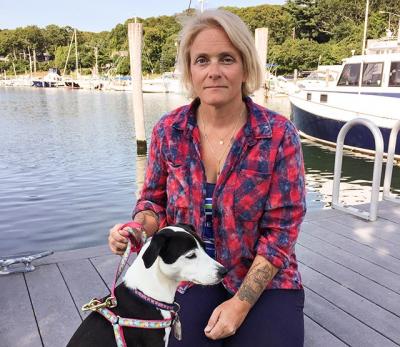St. John in Irma’s Eye and the South Fork’s Heart

More than a week after Hurricane Irma barreled across St. John in the United States Virgin Islands, where many have close ties to the South Fork, people from here who have houses there, or who live there and were evacuated, are unsure when or if they will be able to return to the storm-ravaged island. And they are hardly alone. The powerful storm, among the strongest ever recorded in the Atlantic, left a wide swath of destruction stretching all the way from the eastern Caribbean to mainland Florida.
“It looks like a post-apocalyptic wasteland,” Kim Nalepinski said of her community of Coral Bay on St. John.
She was already set to fly north to visit her parents in East Hampton last Thursday, but as forecasts for Irma worsened, with expected landfall on St. John on Sept. 6, her boyfriend and her parents urged her to leave early and to take her dog, Banksy, with her. She did, arriving on Sept. 3 with the dog, a suitcase, and her iPad. “We didn’t know it was going to be a 5 plus, plus,” she said Monday while walking her dog at the town dock on Three Mile Harbor. “They turned it into a ‘plus, plus’; that doesn’t even exist.”
After Irma hit the island as a strong Category 5 hurricane, it was a full day before Ms. Nalepinski got word that her boyfriend, Erich Eyler, was safe. The next day, he left her a voicemail: “Your apartment is destroyed. Your car is totaled. Coral Bay is ruined, and there’s nothing left.” His 40-foot sailboat had sunk, too.
George and Terry Watson of Montauk, who have a house in Coral Bay, were much luckier, Mr. Watson said Tuesday. The house was unscathed, apart from some water damage. “That is nothing compared to some of the devastation,” he said. “I was ready for the worst. . . . We dodged a big bullet.” Ron and Sally Glogg, friends in Montauk who also have a place in Coral Bay, “were lucky too,” Mr. Watson said.
“Coral Bay just had these tornadoes,” Ms. Nalepinski said, relating how the storm affected her part of the island. One house would be fine, and the one next door would be destroyed.
Coral Bay is on the more remote east end of St. John, and its character is “a lot like our East End,” Ms. Nalepinski said. “A lot of people from Montauk have property there. . . . People feel connected to there; it’s like Rincon,” in Puerto Rico, where many Montaukers spend winters.
Communication from St. John remains limited. News of all three tiny U.S. Virgin Islands has been hard to come by in mainstream media outlets, but islanders and their friends in the States have put together their own networks to share information about the damage, what sort of help has arrived, and what may be needed in the coming days, weeks, and months. St. Thomas, the closest to St. John, was also shattered; St. Croix, 40 miles to the south, was largely spared.
By Monday, Ms. Nalepinski had heard that the National Guard had arrived and that private boats from Puerto Rico and St. Croix were taking supplies and offering to evacuate islanders who wanted to leave.
“Every day, everyone goes to the ball field to see what’s next, to trade information, and to stand on line to use a satellite phone,” she said. A curfew was in effect on St. John from 6 p.m. to noon, and word was that a cruise liner was headed there with more supplies and more spots for those who wanted to leave. While St. John — at just 28 square miles, much of it National Park land — may not yet be the focus of intense relief efforts, “so many people are mobilizing money and support and planes,” Ms. Nalepinski said.
Her own future is uncertain, but she is more concerned with the fate of the community she has called home for the past seven years. She has suggested St. John Rescue, an all-volunteer nonprofit that provides emergency rescue and medical support services, for contributions. It has set up a gofundme page for donations.
Although St. John Rescue reported Sunday that contributions had “helped us secure private jets, high-tech medical and rescue equipment, a K-9 rescue team, and the volunteer services of dozens of highly trained medical professionals,” it also said that “unfortunately, the need is greater than anyone anticipated. Many St. Johnians remain missing. Homes and businesses have been destroyed, public infrastructure decimated. Nearly every wooden structure has suffered severe damage,” and the island is in “desperate need of food, water purification, fuel, generators, medical supplies, and clothing.”
Here on the South Fork, people like the Watsons, whose property fared well, are still not sure when they will get there to assess the situation. “I’ve heard all the power lines are down,” Mr. Watson said Tuesday. “I can’t go down there until they get power.”
Ms. Nalepinski is in East Hampton indefinitely, with nowhere on St. John to live, her possessions destroyed with her apartment, and no word yet whether her job with a veterinary facility will even be there when she returns. Still, she is doing what she can from here to draw attention and help to her island community.
“The vibe is to rebuild,” she said.
